Wearables Meet IoT: Synergistic Personal Area Networks (SPANs)
Abstract
:1. Introduction
2. Wearables
3. IoT Sensing
4. SPAN: Synergy of Information from Wearables and IoT Sensors
- Vital sign monitoring provides snapshots or continuous measurements of the user’s vital signs, such as heart rate, respiration rate, and blood pressure.
- 2.
- Activity monitoring can be implemented using:
- Inertial sensors embedded in IoT objects or wearable inertial sensor on user [8];
- Touch sensors that are typically implemented as capacitive or pressure sensors and can indicate the use of a smart object;
- Mechanical and magnetic sensors can indicate opening or general use of the device. For example, the smart pill bottle from Adhere Tech can detect the use of the bottle and transmit information in real-time to the medical server to facilitate drug compliance monitoring of patients [32]. Nonadherence in the U.S. is estimated to be $100–$300 billions of avoidable health costs [33].
- 3.
- Location sensing. The location of the user could be information itself or provide context for measurements. For example, outdoor location (e.g., home, office, physician’s office, park) provides information about activity during the day, but also the context of measurements, such as:
- Blood pressure measurements are typically higher when measured in physician’s office than at home;
- The number of bathroom visits might indicate the development of urinary tract infection;
- User association for automated measurements, such as assigning automated weight scale measurement with the user closest to the weight scale.
- 4.
- 5.
- 6.
- Wide area networks (WANs) use wired, long-range wireless, or cell-phone network connections to interface short-range networks to the Internet and store records in the cloud and on the medical server. That allows physicians, users, and their caregivers access to all the records that the user wants to share with them [38].
4.1. SPAN Applications
4.1.1. User Identification
- Vital sign-based user identification [39,40]. If the IoT object (smart stuff) contains a vital sign monitor, the user with a wearable sensor that monitors the same vital sign can be identified based on the similarity of vital signs from both sensors. For example, heart rate acquired on the water bottle is compared with heart rate from the smartwatch of users in the vicinity. A similar heart rate or a sequence of heart rate values can identify the subject, particularly in the case of the limited number of subjects sharing the same space (e.g., a couple living together, or nursing home). Subject identification may facilitate the annotation of automatically collected records. Javaid et al. present the use of the wearable ECG and tiles with ballistocardiogram (BCG) for user identification and home monitoring [40].
- Activity-based user identification. Interaction with a smart object causes certain activity parameters to be similar, which can lead to user identification. For example, wearable inertial sensors might have some or multiple parameters very similar to the equivalent parameters on the object. We illustrated user identification using the three axis (3D) accelerometer on the smartwatch of the user and in a smart water bottle in Figure 4. A dynamic 3D vector magnitude with no baseline for the smartwatch and the smart water bottle become very similar when the hand holds the water bottle, as can be seen in Figure 4. Therefore, the system can detect if somebody is using my water bottle. That information is critical in nursing homes and hospitals, where detection of the use of a water bottle by an “unauthorized” user might represent a significant health hazard. Moreover, “authorized” users, such as nurses, do not trigger the alarm.
- Identification of the class of users, such as child vs. adult. In [41] we present how capacitive sensing on multiple segments of the object can be used to detect a pattern of the contact interface that can be used to detect if the person handling the object is an adult or a child. In the case of the smaller number of known users (e.g., family members), the system can identify individuals using the object. “Smart” bottles equipped with sensing technology have substantial potential to detect hazardous events, provide instant alarms and warnings to children who handle bottles containing dangerous products, and warn parents/guardians, wherever they are, via text message or other means.
4.1.2. Synergistic Physiological Monitoring
5. Conclusions and Future Work
6. Patents
Funding
Acknowledgments
Conflicts of Interest
References
- Peek, S.T.M.; Luijkx, K.G.; Rijnaard, M.D.; Nieboer, M.E.; van der Voort, C.S.; Aarts, S.; van Hoof, J.; Vrijhoef, H.J.M.; Wouters, E.J.M. Older Adults’ Reasons for Using Technology while Aging in Place. Gerontology 2016, 62, 226–237. [Google Scholar] [CrossRef] [PubMed]
- Flores, M.; Glusman, G.; Brogaard, K.; Price, N.D.; Hood, L. P4 medicine: How systems medicine will transform the healthcare sector and society. Pers. Med. 2013, 10, 565–576. [Google Scholar] [CrossRef] [PubMed]
- Majumder, S.; Mondal, T.; Deen, M.J. Wearable Sensors for Remote Health Monitoring. Sensors 2017, 17, 130. [Google Scholar] [CrossRef] [PubMed]
- Istepanian, R.S.H.; Jovanov, E.; Zhang, Y.T. Guest Editorial Introduction to the Special Section on M-Health: Beyond Seamless Mobility and Global Wireless Health-Care Connectivity. IEEE Trans. Inf. Technol. Biomed. 2004, 8, 405–414. [Google Scholar] [CrossRef] [PubMed] [Green Version]
- Milosevic, M.; Milenkovic, A.; Jovanov, E. mHealth @ UAH: Computing infrastructure for mobile health and wellness monitoring. XRDS Crossroads ACM Mag. Stud. 2013, 20, 43–49. [Google Scholar] [CrossRef]
- Al-Fuqaha, A.; Guizani, M.; Mohammadi, M.; Aledhari, M.; Ayyash, M. Internet of Things: A Survey on Enabling Technologies, Protocols, and Applications. IEEE Commun. Surv. Tutor. 2015, 17, 2347–2376. [Google Scholar] [CrossRef]
- Swan, M. Sensor Mania! The Internet of Things, Wearable Computing, Objective Metrics, and the Quantified Self 2.0. J. Sens. Actuator Netw. 2012, 1, 217–253. [Google Scholar] [CrossRef] [Green Version]
- Jovanov, E.; Nallathimmareddygari, V.R.; Pryor, J.E. A case study of a smart water bottle. In Proceedings of the 38th Annual International Conference of the IEEE Engineering in Medicine and Biology Society (EMBC), Orlando, FL, USA, 16–20 August, 2016; pp. 6307–6310. [Google Scholar]
- Zimmerman, T.G. Personal Area Networks: Near-field intrabody communication. IBM Syst. J. 1996, 35, 609–617. [Google Scholar] [CrossRef] [Green Version]
- Heile, B.; Giggords, J.; Siep, T. The IEEE P802.15 working group for wireless personal area networks. IEEE Netw. 1999, 13, 4–5. [Google Scholar]
- Jovanov, E.; Price, J.; Raskovic, D.; Kavi, K.; Martin, T.; Adhami, R. Wireless personal area networks in telemedical environment. In Proceedings of the 2000 IEEE EMBS International Conference on Information Technology Applications in Biomedicine. ITAB-ITIS 2000. Joint Meeting Third IEEE EMBS International Conference on Information Technology Applications in Biomedicine (ITAB’00). Third Works, Arlington, VA, USA, 9–10 November 2000; pp. 22–27. [Google Scholar]
- Raskovic, D.; Milenkovic, A.; De Groen, P.; Jovanov, E. From Telemedicine to Ubiquitous M-Health: The Evolution of e-Health Systems. In Biomedical Information Technology; Feng, D., Ed.; Elsevier: Burlington, MA, USA, 2007. [Google Scholar]
- Olla, P.; Shimskey, C. mHealth taxonomy: A literature survey of mobile health applications. Health Technol. 2015, 4, 299–308. [Google Scholar] [CrossRef]
- Madhushri, P.; Dzhagaryan, A.; Jovanov, E.; Milenkovic, A. An mHealth Tool Suite for Mobility Assessment. Information 2016, 7, 47. [Google Scholar] [CrossRef]
- Jovanov, E.; Wright, S.; Ganegoda, H. Development of an Automated 30 Second Chair Stand Test Using Smartwatch Application. In Proceedings of the 41st Annual International Conference of the IEEE Engineering in Medicine and Biology Society (EMBC), Berlin, Germany, 23−27 July 2019. [Google Scholar]
- Jovanov, E. Preliminary analysis of the use of smartwatches for longitudinal health monitoring. In Proceedings of the 37th Annual International Conference of the IEEE Engineering in Medicine and Biology Society (EMBC), Milan, Italy, 25–29 August 2015; pp. 865–868. [Google Scholar]
- Internet of Things forecast – Ericsson Mobility Report - Ericsson. Available online: https://www.ericsson.com/en/mobility-report/internet-of-things-forecast (accessed on 19 August 2019).
- Wu, F.; Wu, T.; Yuce, M.R. An Internet-of-Things (IoT) Network System for Connected Safety and Health Monitoring Applications. Sensors 2019, 19, 21. [Google Scholar] [CrossRef] [PubMed]
- Hassanalieragh, M.; Page, A.; Soyata, T.; Sharma, G.; Aktas, M.; Mateos, G.; Kantarci, B.; Andreescu, S. Health Monitoring and Management Using Internet-of-Things (IoT) Sensing with Cloud-Based Processing: Opportunities and Challenges. In Proceedings of the IEEE International Conference on Services Computing, New York, NY, USA, 27 June–2 July 2015; pp. 285–292. [Google Scholar]
- Manogaran, G.; Shakeel, P.M.; Fouad, H.; Nam, Y.; Baskar, S.; Chilamkurti, N.; Sundarasekar, R. Wearable IoT Smart-Log Patch: An Edge Computing-Based Bayesian Deep Learning Network System for Multi Access Physical Monitoring System. Sensors 2019, 19, 3030. [Google Scholar] [CrossRef] [PubMed]
- Rodrigues, J.J.P.C.; De Rezende Segundo, D.B.; Junqueira, H.A.; Sabino, M.H.; Al-Muhtadi, J.; De Albuquerque, V.H.C. Enabling Technologies for the Internet of Health Things. IEEE Access 2018, 6, 13129–13141. [Google Scholar] [CrossRef]
- Darwish, A.; Sayed, G.I.; Hassanien, A.E. The Impact of Implantable Sensors in Biomedical Technology on the Future of Healthcare Systems. In Intelligent Pervasive Computing Systems for Smarter Healthcare; John Wiley & Sons, Ltd.: Hoboken, NJ, USA, 2019; pp. 67–89. [Google Scholar]
- Nallathimmareddygari, V. Performance Analysis of Smart Water Bottle as IoT device. Master’s Thesis, University of Alabama in Huntsville, Huntsville, AL, 2016. [Google Scholar]
- MAX30100 Pulse Oximeter and Heart-Rate Sensor. Available online: https://www.maximintegrated.com/en/products/sensors/MAX30100.html (accessed on 2 October 2019).
- Pryor, J. Feasibility of Physiological Monitoring Embedded in Smart Stuff. Master’s Thesis, University of Alabama in Huntsville, Huntsville, AL, USA, 2017. [Google Scholar]
- NXP Kinetis K20-72 MHz MCU ArmCortex-M4 Core. Available online: https://www.nxp.com/products/processors-and-microcontrollers/arm-based-processors-and-mcus/kinetis-cortex-m-mcus/k-seriesperformancem4/k2x-usb/kinetis-k20-72-mhz-full-speed-usb-mixed-signal-integration-microcontrollers-mcus-based-on-arm-cortex-m4-core:K20_72?fpsp=1&tab=Documentation_Tab (accessed on 2 October 2019).
- K20 Sub-Family Reference Manual. Available online: https://www.nxp.com/docs/en/reference-manual/K20P64M72SF1RM.pdf (accessed on 2 October 2019).
- Jovanov, E. Vital Sign Monitoring Using Capacitive Sensing. In Proceedings of the 40th Annual International Conference of the IEEE Engineering in Medicine and Biology Society, Honolulu, HI, USA, 18–21 July 2018. [Google Scholar]
- Li, W.; Tan, B.; Piechocki, R. Passive Radar for Opportunistic Monitoring in e-Health Applications. J. Transl. Eng. Health Med. 2018, 6. [Google Scholar] [CrossRef] [PubMed]
- McDuff, D.; Gontarek, S.; Picard, R.W. Improvements in Remote Cardiopulmonary Measurement Using a Five Band Digital Camera. IEEE Trans. Biomed. Eng. 2014, 61, 2593–2601. [Google Scholar] [CrossRef]
- Yang, H.; Xue, T.; Li, F.; Liu, W.; Song, Y. Graphene: Diversified Flexible 2D Material for Wearable Vital Signs Monitoring. Adv. Mater. Technol 2019, 4, 1800574. [Google Scholar] [CrossRef]
- AdhereTech. Available online: https://adheretech.com (accessed on 2 October 2019).
- Iuga, A.O.; McGuire, M.J. Adherence and health care costs. Risk Manag. Healthc. Policy 2014, 7, 35–44. [Google Scholar] [Green Version]
- Kaushik, A.R.; Lovell, N.H.; Celler, B.G. Evaluation of PIR Detector Characteristics for Monitoring Occupancy Patterns of Elderly People Living Alone at Home. In Proceedings of the 2007 29th Annual International Conference of the IEEE Engineering in Medicine and Biology Society, Lyon, France, 22–26 August 2007; pp. 3802–3805. [Google Scholar]
- Proteus Digital Health. Available online: https://www.proteus.com/ (accessed on 14 August 2019).
- Virdi, N.S. Digital Medicines to Measure Drug Ingestion Adherence. In Drug Adherence in Hypertension and Cardiovascular Protection; Burnier, M., Ed.; Springer: Cham, Switzerland, 2018; pp. 87–97. [Google Scholar]
- Jovanov, E.; Poon, C.C.Y.; Yang, G.-Z.; Zhang, Y.T. Guest Editorial Body Sensor Networks: From Theory to Emerging Applications. IEEE Trans. Inf. Technol. Biomed. 2009, 13, 859–863. [Google Scholar] [CrossRef]
- Jovanov, E.; Milenkovic, A.; Otto, C.; de Groen, P. A wireless body area network of intelligent motion sensors for computer assisted physical rehabilitation. J. NeuroEngineering Rehabil. 2005, 2, 2–6. [Google Scholar] [CrossRef]
- Bao, S.; Poon, C.C.Y.; Zhang, Y.; Shen, L. Using the Timing Information of Heartbeats as an Entity Identifier to Secure Body Sensor Network. IEEE Trans. Inf. Technol. Biomed. 2008, 12, 772–779. [Google Scholar] [PubMed]
- Javaid, A.Q.; Chang, I.S.; Mihailidis, A. Ballistocardiogram Based Identity Recognition: Towards Zero-Effort Health Monitoring in an Internet-of-Things (IoT) Environment. In Proceedings of the 40th Annual International Conference of the IEEE Engineering in Medicine and Biology Society (EMBC), Honolulu, HI, USA, 18–21 July 2018; pp. 3326–3329. [Google Scholar]
- Jovanov, E.; Talukder, B.B.M.S.; Schwebel, D.C.; Evans, D.W. Design and Feasibility of a Safe Pill Bottle. Appl. Syst. Innov. 2018, 1, 13. [Google Scholar] [CrossRef]
- Millasseau, S.C.; Stewart, A.D.; Patel, S.J.; Redwood, S.R.; Chowienczyk, P.J. Evaluation of Carotid-Femoral Pulse Wave Velocity. Hypertension 2005, 45, 222–226. [Google Scholar] [CrossRef] [PubMed] [Green Version]
- Chen, Y.; Wen, C.; Tao, G.; Bi, M.; Li, G. Continuous and Noninvasive Blood Pressure Measurement: A Novel Modeling Methodology of the Relationship Between Blood Pressure and Pulse Wave Velocity. Ann. Biomed. Eng. 2009, 37, 2222–2233. [Google Scholar]
- Díaz, A.; Galli, C.; Tringler, M.; Ramírez, A.; Cabrera Fischer, E.I. Reference Values of Pulse Wave Velocity in Healthy People from an Urban and Rural Argentinean Population. Int.J. Hypertens. 2014, 2014, 653239. [Google Scholar] [CrossRef]
- Pielmuş, A.-G.; Pflugradt, M.; Tigges, T.; Klum, M.; Feldheiser, A.; Hunsicker, O.; Orglmeister, R. Novel computation of pulse transit time from multi-channel PPG signals by wavelet transform. Curr. Dir. Biomed. Eng. 2016, 2, 209–213. [Google Scholar] [CrossRef]
- Spronck, B.; Heusinkveld, M.H.G.; Vanmolkot, F.H.; Roodt, J.; Hermeling, E.; Delhaas, T.; Kroon, A.A.; Reesink, K.D. Pressure-dependence of arterial stiffness: Potential clinical implications. J. Hypertens. 2015, 33, 330–338. [Google Scholar] [CrossRef]
- Rajala, S.; Lindholm, H.; Taipalus, T. Comparison of photoplethysmogram measured from wrist and finger and the effect of measurement location on pulse arrival time. Physiol. Meas. 2018, 39, 075010. [Google Scholar] [CrossRef]
- Martin, S.L.-O.; Carek, A.M.; Kim, C.-S.; Ashouri, H.; Inan, O.T.; Hahn, J.-O.; Mukkamala, R. Weighing Scale-Based Pulse Transit Time is a Superior Marker of Blood Pressure than Conventional Pulse Arrival Time. Sci. Rep. 2016, 6, 39273. [Google Scholar] [CrossRef]
- El aboudi, N.; Benhlima, L. Big Data Management for Healthcare Systems: Architecture, Requirements, and Implementation. Adv. Bioinforma. 2018, 2018, 4059018. [Google Scholar] [CrossRef]
- Pernice, R.; Parisi, A.; Adamo, G.; Guarino, S.; Faes, L.; Busacca, A. A portable system for multiple parameters monitoring: Towards assessment of health conditions and stress level in the automotive field. In Proceedings of the AEIT International Conference of Electrical and Electronic Technologies for Automotive (AEIT AUTOMOTIVE), Torino, Italy, 2−4 July 2019; pp. 1–6. [Google Scholar]
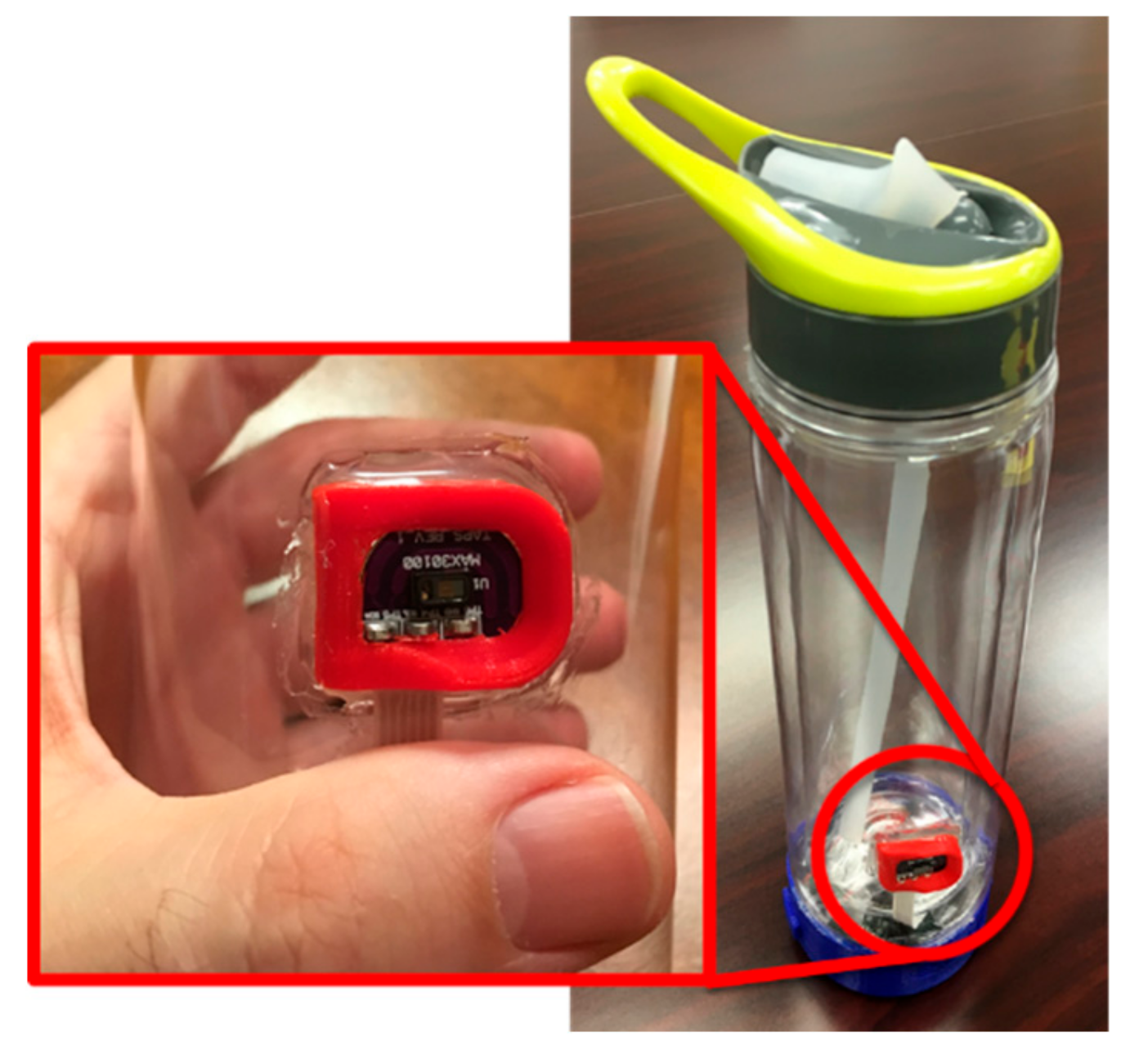
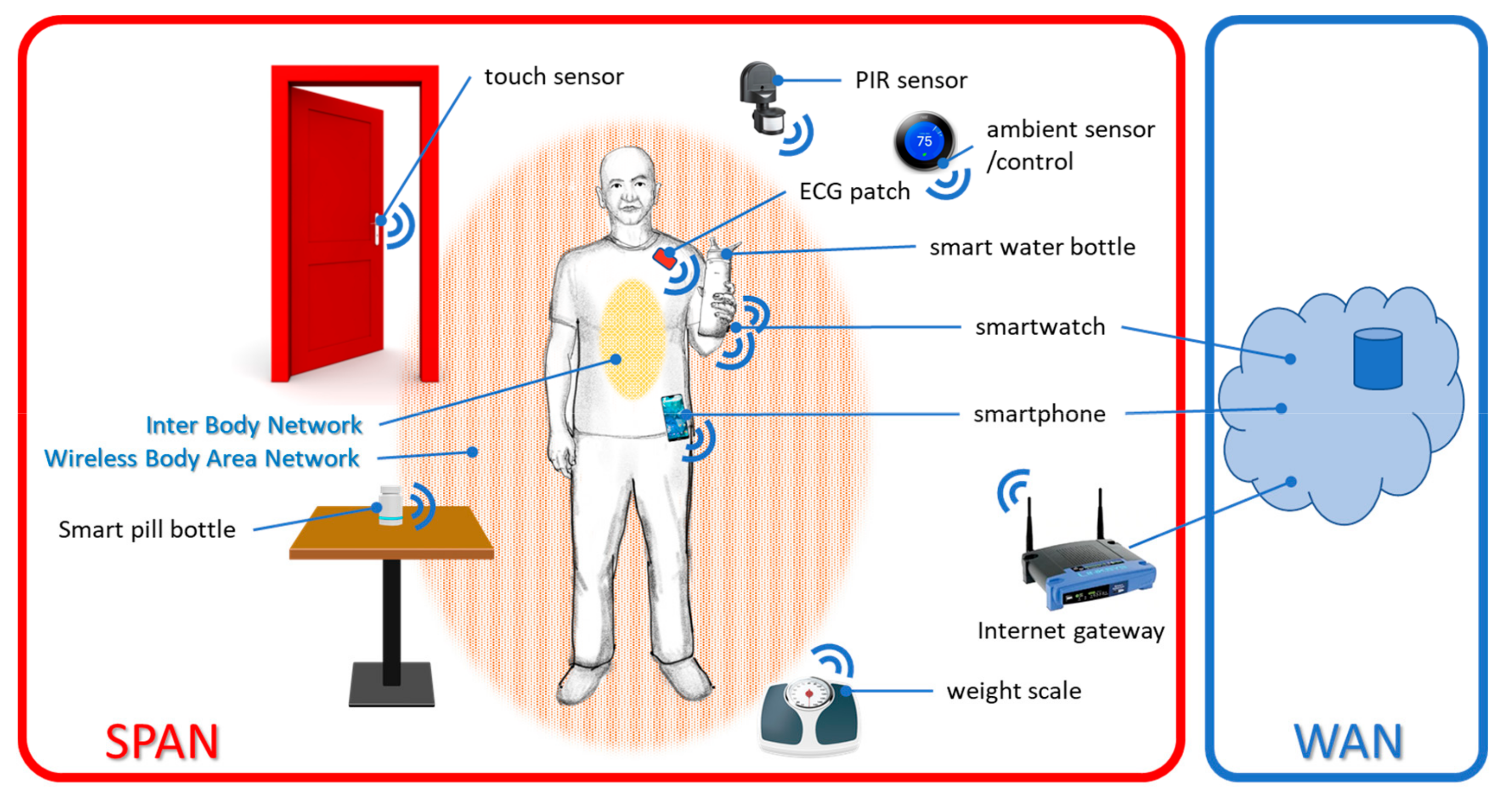
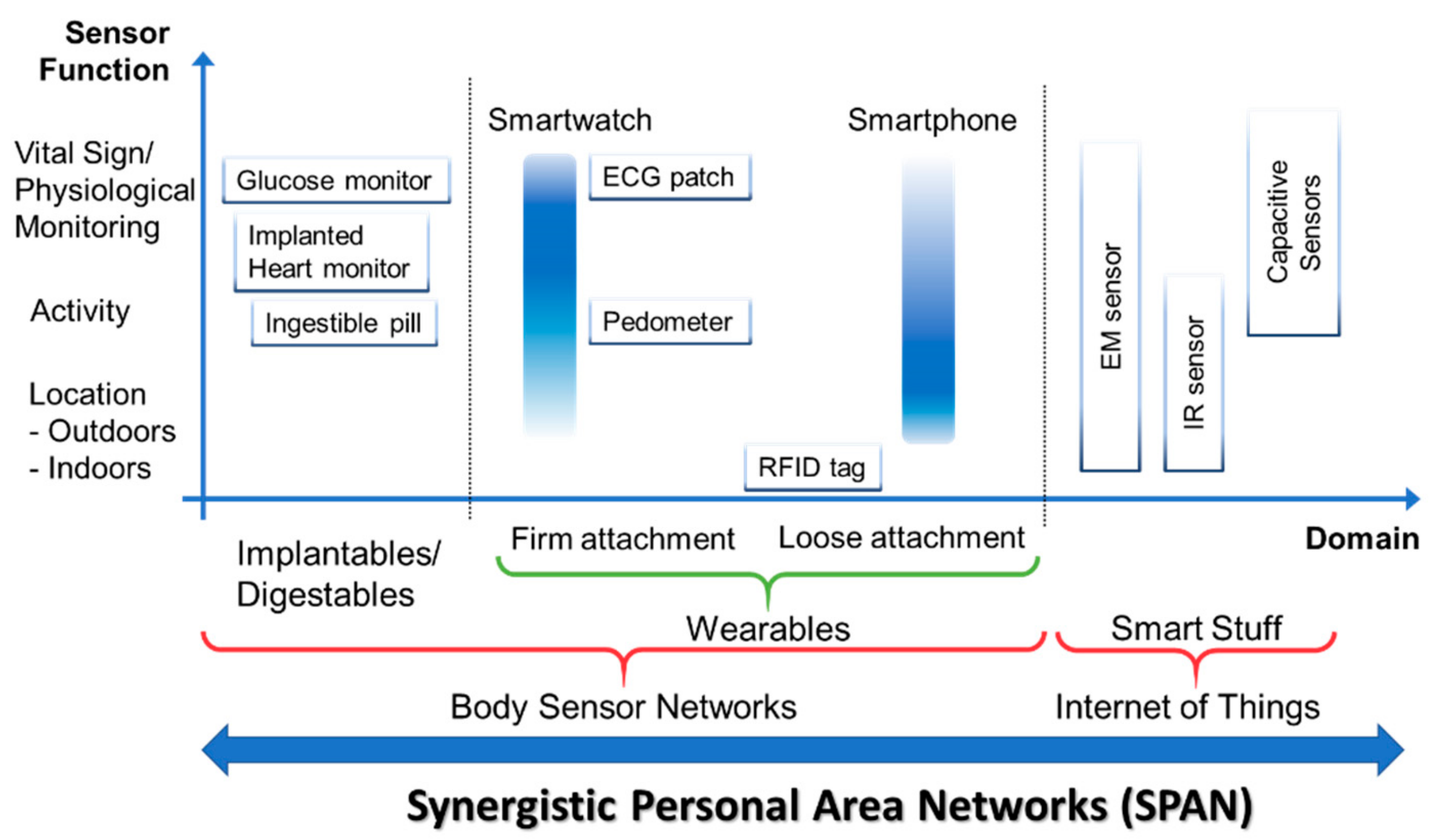
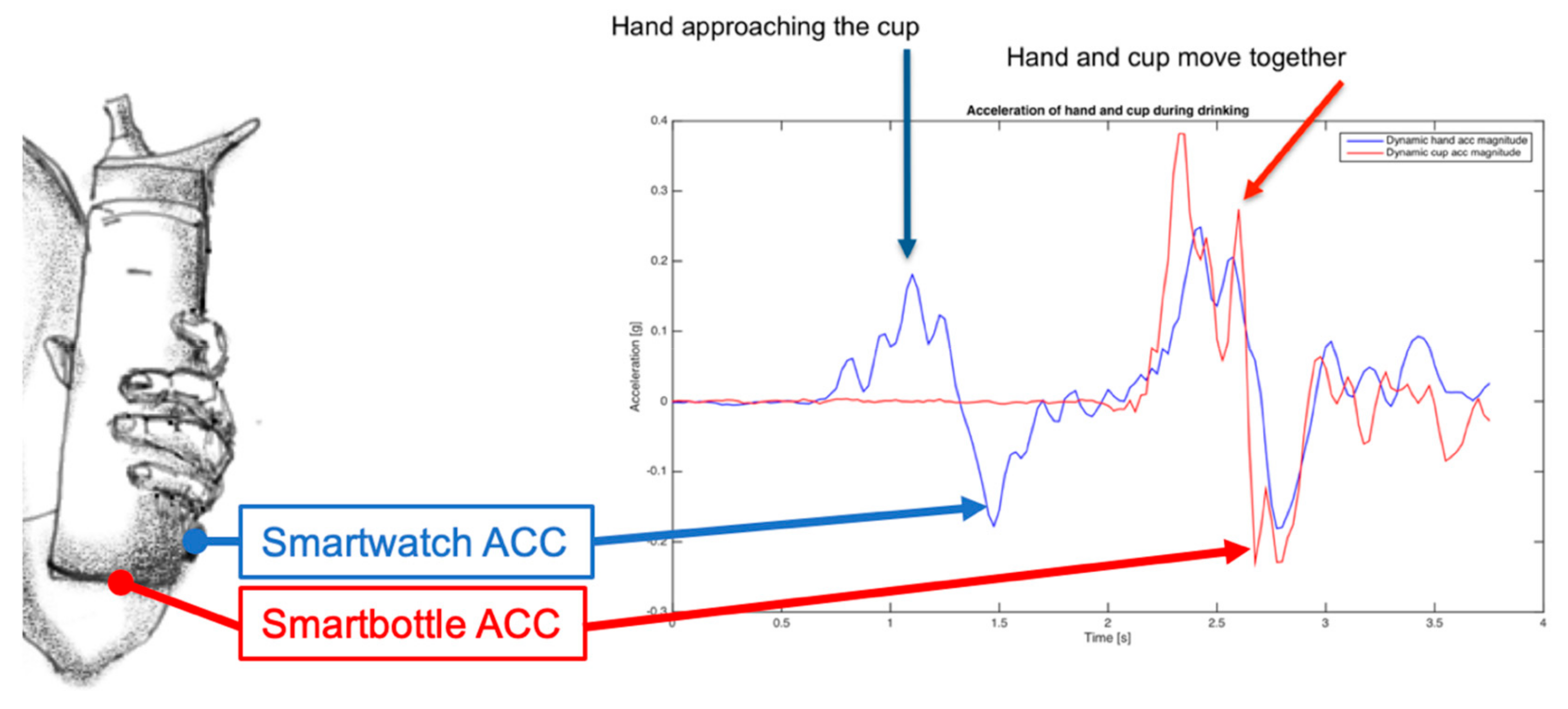
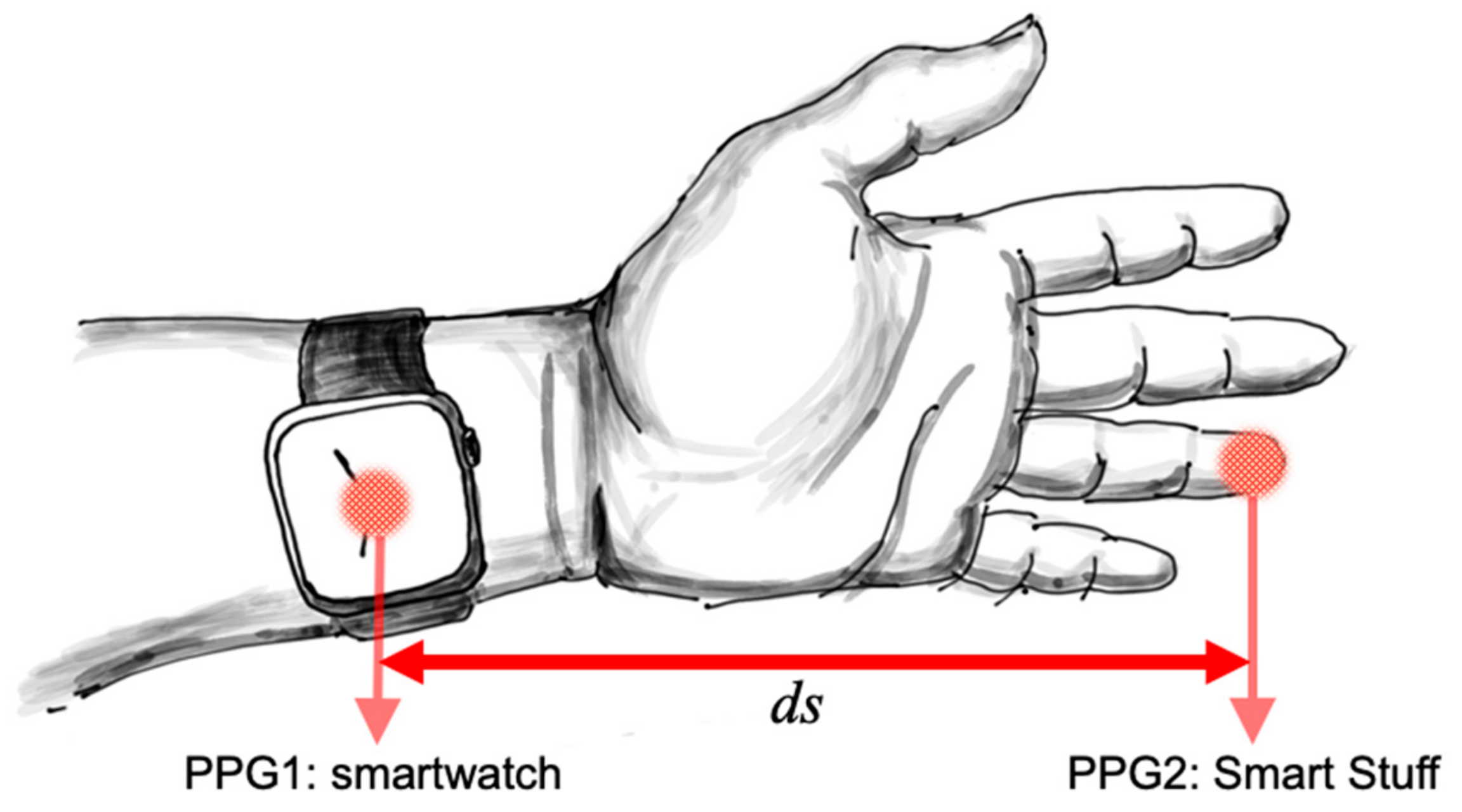

© 2019 by the author. Licensee MDPI, Basel, Switzerland. This article is an open access article distributed under the terms and conditions of the Creative Commons Attribution (CC BY) license (http://creativecommons.org/licenses/by/4.0/).
Share and Cite
Jovanov, E. Wearables Meet IoT: Synergistic Personal Area Networks (SPANs). Sensors 2019, 19, 4295. https://doi.org/10.3390/s19194295
Jovanov E. Wearables Meet IoT: Synergistic Personal Area Networks (SPANs). Sensors. 2019; 19(19):4295. https://doi.org/10.3390/s19194295
Chicago/Turabian StyleJovanov, Emil. 2019. "Wearables Meet IoT: Synergistic Personal Area Networks (SPANs)" Sensors 19, no. 19: 4295. https://doi.org/10.3390/s19194295
APA StyleJovanov, E. (2019). Wearables Meet IoT: Synergistic Personal Area Networks (SPANs). Sensors, 19(19), 4295. https://doi.org/10.3390/s19194295




